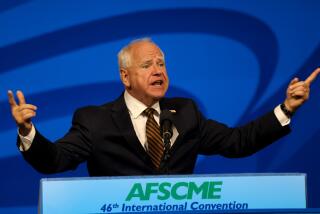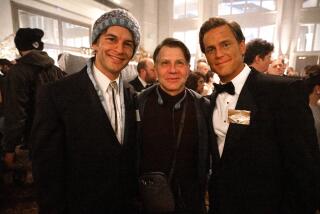Book Review : Provocative Call to Arms on Gay Rights
After the Ball: How America Will Conquer Its Fear & Hatred of Gays in the ‘90s by Marshall Kirk and Hunter Madsen (Doubleday: $19.95).
One out of 10 Americans is gay, according to Marshall Kirk and Hunter Madsen in “After the Ball,” and these 25 million men and women are “forced to cower and skulk like a German Jew of the ‘30s.” They are the victims of “a national sickness” that manifests itself in the fear and hatred of homosexuality. The only appropriate response from the gay community--and the only way to put an end to their oppression--is “ice-cold, controlled, directed rage.”
But “After the Ball” is not a call to the barricades; rather, it is a curious call to the story boards and 30-second spots of Madison Avenue, a kind of sanitized upscale media radicalism that finds mass demonstrations to be “ghastly freak shows” and prefers highway billboards that “earnestly propound appealing truisms, the safer and more platitudinous, the better.” As the authors readily admit: “We’re talking about propaganda.”
“After the Ball” is a stubbornly revisionist critique of the conventional wisdom of gay activism over the last two decades (“The gay revolution has failed,” the authors announce at the very outset); a study of the origins and workings of contemporary attitudes toward gay men and women; and, above all, “a practical agenda for bringing to a close, at long last, the seemingly permanent crisis of American homosexuality.”
The book opens with a wide-ranging and penetrating survey of what the authors call “homochondria” and “homo-hatred,” ranging from coarse back-room bigotry to the veiled slander of television advertising. But the essential message of the book is an urgent demand for a fundamental change in the very nature of gay activism. The gay community, Kirk and Madsen argue, has resorted to the wrong arguments, the wrong symbols, and the wrong acts of protest. And the authors of “After the Ball’ think that they have a better idea.
“We’re assumed to consist entirely of extreme stereotypes: men ultra swishy and ultraviolet, Frankensteinian thug-women with bolts on their necks, mustachio’d Dolly Parton wanna-bes, leather-men in boots and whips, ombudsmen of pederasty squiring their ombudsboys--all ridiculous, deranged, or criminal,” the authors write. “And when we are finally allowed to rally and march, to lay our case before the cameras of the straight American public, what do we do? We call out of the woodwork as our ambassadors of bad will all the screamers, stompers, gender-benders, sadomasochists, and pederasts, and confirm America’s worst fears and hates. You can call it gay liberation if you like: we say it’s spinach, and we say the hell with it!”
Instead, they have devised a program of gay advocacy based on media-wise techniques of image manipulation: “A continuous flood of gay-related advertising” that will depict gays “in the least offensive fashion possible” while making “homo-hating beliefs and actions look so nasty that average Americans will want to dissociate themselves from them.” This is pure propaganda, of course, but it is propaganda on the highest levels of insight and calculation.
“We have in mind a strategy as calculated and powerful as that which gays are accused of pursuing by their enemies--or, if you prefer, a plan as manipulative as that which our enemies themselves employ,” Kirk and Madsen declare. “It’s time to learn from Madison Avenue, to roll out the big guns.”
Changed Behavior
To their credit, Kirk and Madsen do not make the mistake of piling all of their expectations on “image-management techniques.” They also call for changes in what they frankly characterize as the “misbehavior”--sexual and otherwise--of the gay community. “Straights hate gays not just for what their myths and lies say we are, but also for what we really are,” the authors write. “All the squeaky-clean media propaganda in the world won’t sustain a positive image in the long unless we start scrubbing to make ourselves a little squeakier and cleaner in reality. And, as it happens, our noses (and other parts) are far from clean.”
I don’t think Kirk or Madsen would disagree with my observation that “After the Ball” is an uncomfortable book--their self-proclaimed mission is to shock and provoke their readers, whether gay or straight. But it’s also true that their ideas are so lively and provocative, their language so rich and spirited, that I came to admire and enjoy “After the Ball” even in its moments of rhetorical excess. (And, if I may say so, the graphic design of the book, credited to Carol Malcolm, is as elegant, handsome and functional as any I’ve seen.)
More to Read
Sign up for our Book Club newsletter
Get the latest news, events and more from the Los Angeles Times Book Club, and help us get L.A. reading and talking.
You may occasionally receive promotional content from the Los Angeles Times.






